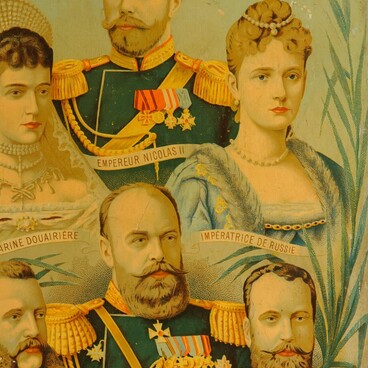The gravy boat is mass-produced. Like other items from the dinner service, the gravy boat is simple but elegant, with a nice combination of gold white and gold under a shiny glaze.
Gravy boats acquired their present form in the second half of the 17th century when they came into fashion at the French court. However, it was in Britain in the 1740s that porcelain was first used to produce gravy boats. The vessels became affordable for the middle class in the second half of the 18th century as their design became simpler with the disappearance of second handles and spouts. By the end of the 18th century gravy boats became an essential part of a dinner set.
This gravy boat is part of a dinner set produced by M.S. Kuznetsov Partnership Manufacture of Porcelain and Faience in Dulyovo. At the end of the 19th century it was the biggest porcelain and faience production in the Russian Empire, and all of Kuznetsov’s factories included gravy boats in their dinner sets.
The factory in Dulyovo reached the peak of its development under a talented industrialist Matvey Kuznetsov. His talent for pottery was probably due to the fact that all his ancestors were from Gzhel, a renowned center of traditional blue-and-white ceramics production. The dynasty of porcelain industrialists was founded by his great-grandfather, Yakov Kuznetsov. It was Matvey Kuznetsov who provided all the departments of the factory with modern equipment which he had brought from France. The factory produced both elegant dinner sets for the court and affordable tableware. All the porcelain items were decorated, which greatly contributed to the popularity of the factory. Altogether, Kuznetsov factories employed 1300 full-time workers and 4000 part-time workers. Kuznetsov had his wares in 10 major cities of Russia. Items produced by the “Kuznetsov Porcelain Empire” was top-quality and was awarded with Gold medals at the Fairs in Paris and Tashkent. Porcelain and faience tableware were in high demand not only in Russia, but also in Turkey, Persia (modern-day Iran), Bulgaria, Japan, United States, Austria, India, etc. The production of the giant company was intended for different social segments: rich peasants, bourgeois, merchants. By the end of the 19th century the “Kuznetsov Porcelain Empire” accounted for 75% of all the income of all the porcelain-faience production in the Russian Empire.
In 1902 Matvey Kuznetsov was included in the honorary list of the Suppliers of the Court of His Imperial Majesty. The porcelain empire provided scholarships for the Stroganov Art School and the Artists Society. The production embraced all the newest technologies with lightning speed, which allowed the factory in Dulyovo to become the leader among all the porcelain production manufactures in the late 19th – early 20th centuries.
Gravy boats acquired their present form in the second half of the 17th century when they came into fashion at the French court. However, it was in Britain in the 1740s that porcelain was first used to produce gravy boats. The vessels became affordable for the middle class in the second half of the 18th century as their design became simpler with the disappearance of second handles and spouts. By the end of the 18th century gravy boats became an essential part of a dinner set.
This gravy boat is part of a dinner set produced by M.S. Kuznetsov Partnership Manufacture of Porcelain and Faience in Dulyovo. At the end of the 19th century it was the biggest porcelain and faience production in the Russian Empire, and all of Kuznetsov’s factories included gravy boats in their dinner sets.
The factory in Dulyovo reached the peak of its development under a talented industrialist Matvey Kuznetsov. His talent for pottery was probably due to the fact that all his ancestors were from Gzhel, a renowned center of traditional blue-and-white ceramics production. The dynasty of porcelain industrialists was founded by his great-grandfather, Yakov Kuznetsov. It was Matvey Kuznetsov who provided all the departments of the factory with modern equipment which he had brought from France. The factory produced both elegant dinner sets for the court and affordable tableware. All the porcelain items were decorated, which greatly contributed to the popularity of the factory. Altogether, Kuznetsov factories employed 1300 full-time workers and 4000 part-time workers. Kuznetsov had his wares in 10 major cities of Russia. Items produced by the “Kuznetsov Porcelain Empire” was top-quality and was awarded with Gold medals at the Fairs in Paris and Tashkent. Porcelain and faience tableware were in high demand not only in Russia, but also in Turkey, Persia (modern-day Iran), Bulgaria, Japan, United States, Austria, India, etc. The production of the giant company was intended for different social segments: rich peasants, bourgeois, merchants. By the end of the 19th century the “Kuznetsov Porcelain Empire” accounted for 75% of all the income of all the porcelain-faience production in the Russian Empire.
In 1902 Matvey Kuznetsov was included in the honorary list of the Suppliers of the Court of His Imperial Majesty. The porcelain empire provided scholarships for the Stroganov Art School and the Artists Society. The production embraced all the newest technologies with lightning speed, which allowed the factory in Dulyovo to become the leader among all the porcelain production manufactures in the late 19th – early 20th centuries.



